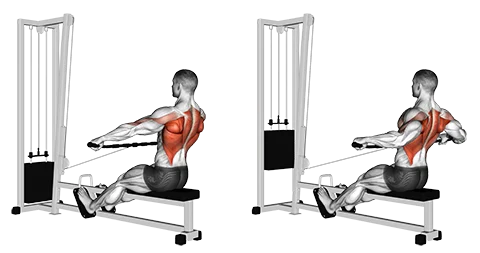Introduction
The "Seated Cable Row with Wide Grip" exercise targets the back muscles, particularly the latissimus dorsi and rhomboids. It strengthens these muscles, improving posture and reducing the risk of injury. This exercise is particularly effective for individuals seeking to develop a broad, defined upper back and improve their pulling strength, which is beneficial for various fitness goals such as weightlifting and functional fitness activities.
Muscles Worked
- Primary: Latissimus Dorsi, Rhomboids, Biceps Brachii
- Secondary: Trapezius, Erector Spinae, Forearm Flexors
How to Do It (Step-by-Step)
- Sit on a seated cable row machine with your knees slightly bent and feet firmly planted on the footplate. Grasp the wide grip handles with an overhand grip.
- Pull the handles towards your lower abdomen while keeping your elbows close to your body.
- Maintain a neutral spine, avoid rounding the back, and keep your shoulders down during the exercise.
Tip: Keep your reps slow and controlled to ensure proper muscle engagement and prevent swinging of the torso.
Rep & Rest Guidelines
- Strength: 4–6 reps, 2–3 min rest
- Hypertrophy: 8–12 reps, 60–90 sec rest
- Endurance: 12–20 reps, 30–60 sec rest
Train smarter with Auto Progression for optimal results. Stay on track with the built-in Rest Timer.
Form Tips
- Maintain a neutral spine and keep your core engaged throughout the exercise.
- Pull the handle towards your lower abdomen, focusing on squeezing your back muscles, rather than just moving your arms.
- Keep your knees slightly bent and avoid locking them during the exercise to reduce strain on your joints.
When to Use It
- Building a wide, powerful back: Aim for 3 sets of 8-12 reps with a moderate weight to strengthen the latissimus dorsi and other large back muscles.
- Enhancing rowing performance: Incorporate seated cable rows in your training routine for strong, functional back muscle development that can boost rowing speed and endurance.
- Rehabilitating injured or weak shoulders: Perform seated cable rows with a light weight and high reps (15+) to build shoulder stability and strengthen the upper back without putting excessive strain on the joints.
Workout History for tracking progress and ensuring consistent improvement in your fitness journey.
Primarily the back muscles, including the latissimus dorsi and erector spinae.
A wider grip emphasizes the lats more than a close grip.
3-4 sets of 8-12 reps is common, but adjust based on your fitness level and goals.
Keep your back straight, hinge at the hips, and pull the cable handle to your lower chest.
Incorporate them into your workout routine 2-3 times a week for best results.

